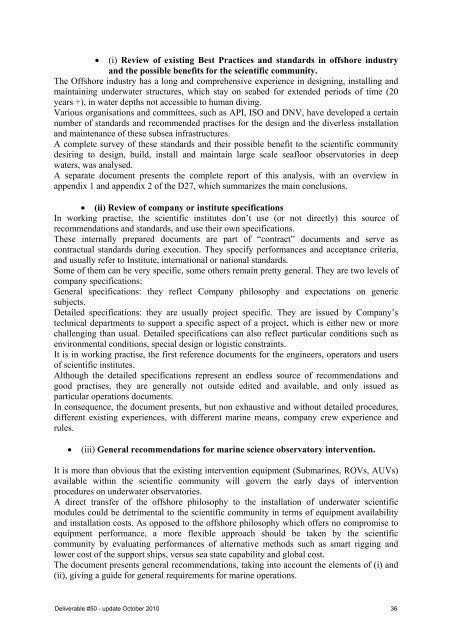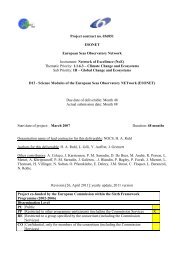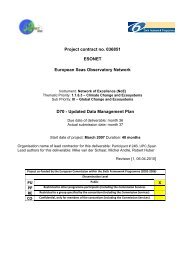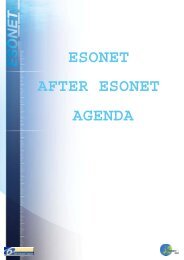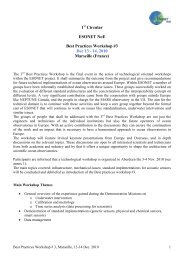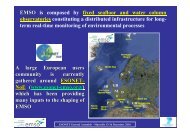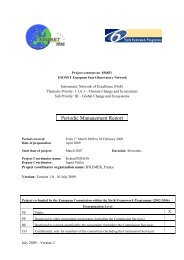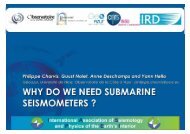Project Deliverable D50 Report on Best Practices ... - ESONET NoE
Project Deliverable D50 Report on Best Practices ... - ESONET NoE
Project Deliverable D50 Report on Best Practices ... - ESONET NoE
Create successful ePaper yourself
Turn your PDF publications into a flip-book with our unique Google optimized e-Paper software.
• (i) Review of existing <strong>Best</strong> <strong>Practices</strong> and standards in offshore industry<br />
and the possible benefits for the scientific community.<br />
The Offshore industry has a l<strong>on</strong>g and comprehensive experience in designing, installing and<br />
maintaining underwater structures, which stay <strong>on</strong> seabed for extended periods of time (20<br />
years +), in water depths not accessible to human diving.<br />
Various organisati<strong>on</strong>s and committees, such as API, ISO and DNV, have developed a certain<br />
number of standards and recommended practises for the design and the diverless installati<strong>on</strong><br />
and maintenance of these subsea infrastructures.<br />
A complete survey of these standards and their possible benefit to the scientific community<br />
desiring to design, build, install and maintain large scale seafloor observatories in deep<br />
waters, was analysed.<br />
A separate document presents the complete report of this analysis, with an overview in<br />
appendix 1 and appendix 2 of the D27, which summarizes the main c<strong>on</strong>clusi<strong>on</strong>s.<br />
• (ii) Review of company or institute specificati<strong>on</strong>s<br />
In working practise, the scientific institutes d<strong>on</strong>’t use (or not directly) this source of<br />
recommendati<strong>on</strong>s and standards, and use their own specificati<strong>on</strong>s.<br />
These internally prepared documents are part of “c<strong>on</strong>tract” documents and serve as<br />
c<strong>on</strong>tractual standards during executi<strong>on</strong>. They specify performances and acceptance criteria,<br />
and usually refer to Institute, internati<strong>on</strong>al or nati<strong>on</strong>al standards.<br />
Some of them can be very specific, some others remain pretty general. They are two levels of<br />
company specificati<strong>on</strong>s:<br />
General specificati<strong>on</strong>s: they reflect Company philosophy and expectati<strong>on</strong>s <strong>on</strong> generic<br />
subjects.<br />
Detailed specificati<strong>on</strong>s: they are usually project specific. They are issued by Company’s<br />
technical departments to support a specific aspect of a project, which is either new or more<br />
challenging than usual. Detailed specificati<strong>on</strong>s can also reflect particular c<strong>on</strong>diti<strong>on</strong>s such as<br />
envir<strong>on</strong>mental c<strong>on</strong>diti<strong>on</strong>s, special design or logistic c<strong>on</strong>straints.<br />
It is in working practise, the first reference documents for the engineers, operators and users<br />
of scientific institutes.<br />
Although the detailed specificati<strong>on</strong>s represent an endless source of recommendati<strong>on</strong>s and<br />
good practises, they are generally not outside edited and available, and <strong>on</strong>ly issued as<br />
particular operati<strong>on</strong>s documents.<br />
In c<strong>on</strong>sequence, the document presents, but n<strong>on</strong> exhaustive and without detailed procedures,<br />
different existing experiences, with different marine means, company crew experience and<br />
rules.<br />
• (iii) General recommendati<strong>on</strong>s for marine science observatory interventi<strong>on</strong>.<br />
It is more than obvious that the existing interventi<strong>on</strong> equipment (Submarines, ROVs, AUVs)<br />
available within the scientific community will govern the early days of interventi<strong>on</strong><br />
procedures <strong>on</strong> underwater observatories.<br />
A direct transfer of the offshore philosophy to the installati<strong>on</strong> of underwater scientific<br />
modules could be detrimental to the scientific community in terms of equipment availability<br />
and installati<strong>on</strong> costs. As opposed to the offshore philosophy which offers no compromise to<br />
equipment performance, a more flexible approach should be taken by the scientific<br />
community by evaluating performances of alternative methods such as smart rigging and<br />
lower cost of the support ships, versus sea state capability and global cost.<br />
The document presents general recommendati<strong>on</strong>s, taking into account the elements of (i) and<br />
(ii), giving a guide for general requirements for marine operati<strong>on</strong>s.<br />
<str<strong>on</strong>g>Deliverable</str<strong>on</strong>g> #50 - update October 2010 36


